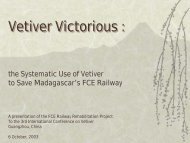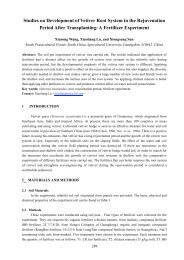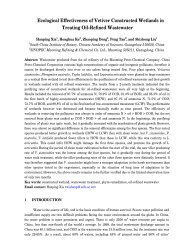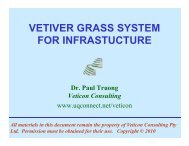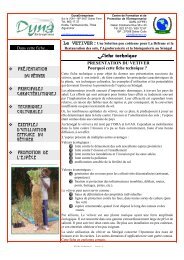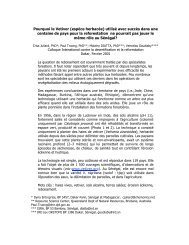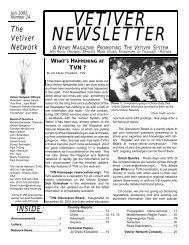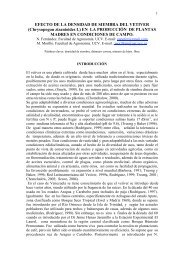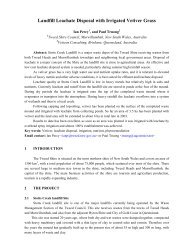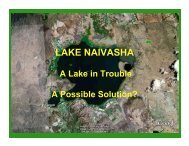BAP03 - The Vetiver Network International
BAP03 - The Vetiver Network International
BAP03 - The Vetiver Network International
You also want an ePaper? Increase the reach of your titles
YUMPU automatically turns print PDFs into web optimized ePapers that Google loves.
<strong>Vetiver</strong> System for NaturalDisasters Reduction in Vietnam –An OverviewTran Tan Van, D.Eng.Vietnam <strong>Vetiver</strong> <strong>Network</strong> CoordinatorResearch Institute of Geology and Mineral ResourcesWith special thanks to colleagues Prof. Paul Truong, Ir. ElisePinners, , Dr. Le Viet Dung and Dr. Pham Hong Duc Phuoc.
VIETNAM AND ITSDISASTER PRONE REGION
FLOODDAMAGES
COASTAL DIKE EROSION BY TYPHOON
INLAND DIKE DIKE EROSION BY TYPHOON
ROAD AND HIGHWAY EROSION BY TYPHOON
RIVERBANK EROSION BY WAVES
RIVERBANK EROSION BY WAVES
ROAD AND HIGHWAY EROSION BY TYPHOON
Present traditional remedial measuresPresent measures are mostly structural e.g.: Building concrete and/or rock rip-rap dyke andembankment against flooding, for coastal andriverbank erosion control; Building passive concrete or rock retaining wall forcontrol of slope failure and road side instability; Building sand dyke or even rock/concreteembankment for sand fly, sand flow control;
Present traditional remedial measuresIn some cases, plants, trees and local grasses areused, e.g. bamboo, casuarinas, wild pineapple, localgrasses etc.;No measures yet for control of sea water intrusion andwater pollution;No measures yet for soil pollution by heavy metals,toxic elements and even by Agent Orange (Dioxin);
<strong>The</strong> bank of the Red River in Hanoi is repaired after recent flood using gabionsand rock baskets
Very slowly and costly, first by a layer of small rocks then by rockbaskets (large size rocks encaged in galvanised steel wire)Rock basketRock rip rap
But the bank was protected exactly the same way in the past. Nowremnants of the old rock baskets collapsed in the recent flood are stillvisible in the river.Remnants of the old rockbaskets
Failure was due to the highly erodible alluvial foundation
Disadvantages of present structural measuresIn most cases, these measures are very localized,i.e. only for the most acute parts of the problemarea. <strong>The</strong>y can never be extended to remedy thewhole disaster affected area;Very expensive (3-5 billion VND, up to 10-15 billionVND/km of embankment) but not effective;State budget can never be sufficient. For example,350 billion VND per province for dyke/river bankprotection but only 5 billion allocated;Structural measures are environmental unfriendlyand not community-based.
Disadvantages of present structural measuresTechnically, rigid structural measures are not suitable because: Stone/concrete has to be mined/produced (causingenvironmental problem) and delivered from somewhere else; Much stone, sand, cement, bank soil etc. is brought ordisposed into the river, raising channel bottom, causingstrong changes in channel bottom and morphology that willsurely worsen the flood and bank erosion problems; <strong>The</strong>y are not compatible with soft ground. Loose soilunderneath is easily eroded/washed away resulting incrack/collapse of upper layer; Can’t t stabilize the bank in case of big, deep landslides; Do not absorb flow/wave energy. Just divert/re-direct thedisaster to another unprotected place, i.e. they oftenaggravate the disasters, doing more harm than good;
Disadvantages of present structural measuresConcrete or rock retaining wall is probably the singleengineering method applied so far for road slopestabilization. Most of these walls are, however,passive, waiting for the slopes to fail. When they dofail, they also cause the walls to fail;Rigid structures like rock embankments are notsuitable at all for sand dune stabilization. <strong>The</strong>y are,however, still built at some places.
Disadvantages of present bio-engineering methodsSofter solutions, using vegetation have also beentried, though to a much less extent. For river bank erosion, the most popular method isplanting bamboo. For coastal erosion, mangrove, casuarinas, wildpineapple etc. are used.
Native grass is equally ineffective
This Phragmites barrier look very impressive from the front
But erosion continues as waves from unprotected sectionupstream got behind it.
Disadvantages of present bio-engineering methodsHowever, these trees have some essential weak points, e.g.: Growing in clumps, bamboo can not provide closedhedgerows. <strong>The</strong> flood water tends to concentrate at gaps in-between clumps, where the water destructive powerincreases, thus causing more erosion to occur; Bamboo has only a shallow (1-1.5 m deep) bunch rootsystem, not in balance with the high, heavy canopy.<strong>The</strong>refore, clumps of bamboo put an additional heavysurcharge on a river bank, without contributing to the bankstability; Bamboo can’t t prevent bank erosion underneath that createsconditions for larger landslides to take place.
Solutions for natural disaster reduction Natural disasters e.g. flood, erosion, landslide, sand fly andsand flow are wide-spread, affecting many communities; Some natural disasters e.g. river bank and coastal erosion-siltation have their causes originated from very far upstream; Some natural disasters, e.g. flood, for some areas e.g. theMekong Delta, may not be disaster at all if well controlled;<strong>The</strong>refore: Macro-scale, non-structural, basin-wide and even inter-basinmanagement should be introduced more widely; <strong>The</strong> present concept of protection using rigid, localized,difficult to apply, expensive, environmental unfriendlystructures should be changed; Reduction measures should be cheap, soft and flexible, easyto apply, community-based and environmental friendly.<strong>The</strong>refore, suitable bio-engineering methods should besought and practiced more widely. One such a solution is the use of <strong>Vetiver</strong> grass.
What is <strong>Vetiver</strong> System<strong>Vetiver</strong> System (VS) is a bio-engineering technology that isused by Indian farmers 200 years ago;But introduced by the World Bank as a measure for naturaldisaster reduction only in early 1980s;Since then, many countries tried, especially the USA, Australia,China, ASEAN countries etc.;In Thailand, the use of <strong>Vetiver</strong> grass is promoted by the King;<strong>The</strong> World <strong>Vetiver</strong> <strong>Network</strong> (TVN) has been established withmany member countries;Various applications on-farm, along roads, rivers, dykes, etc.Many new applications are tried, e.g. for pollution control;Introduced into Vietnam many years ago, but as a measure fornatural disaster reduction only in late 1990s, becoming a boomonly since 2001 with several trial projects in Central Vietnam,Central Highland and Mekong Delta.
LANDSLIP CONTROL MECHANISM BY VETIVER<strong>Vetiver</strong>hedgerows<strong>Vetiver</strong>rootsslipping zone on slopesusually 0~2 m depths
<strong>Vetiver</strong> flourished on the extremely hostile environment of a roadbatter, where few other plant can establishAustralia
Recent applications of <strong>Vetiver</strong> grass in VietnamRecent applications of VS in Vietnam show a greatopportunity to: Protect river banks and dykes; Fix sand dunes, protect sandy banks and Casuarinas; Control on-farm flood erosion and gully development; Prevent landslip, stabilise roadsides; Control soil/water pollution.
Examples: Trial of <strong>Vetiver</strong> grass for protecting sand dunes inQuang Binh. . Establishment of the demo site.
Examples: Trial of <strong>Vetiver</strong> grass for protecting sand dunes inQuang Binh. . Establishment of the demo site.
Examples: Trial of <strong>Vetiver</strong> grass for protecting sand dunes inQuang Binh. . Four months after planting.
Examples: Trial of <strong>Vetiver</strong> grass for protecting sand dunes in QuangBinh. . Four months after planting. <strong>The</strong> grass is more than 1.7 m high.
<strong>The</strong> sand dune is fully stabilized after one year, favouring thegrowth of other trees.
On a badly eroded shrimp pond bank (along a stream/gully nearDa Nang)
Local road along river, near Da Nang. . This road used to be badlydamaged by receding yearly floods.
Examples: Trial of <strong>Vetiver</strong> grass for protecting river bank in DaNang. . Four months after planting. <strong>The</strong> nursery.
<strong>Vetiver</strong> planting on a dyke in An Giang Province, south VN<strong>Vetiver</strong>
<strong>Vetiver</strong> planting on a dyke in An Giang Province, south VN
A section of the river dyke in Quang Ngai.
Quảng Ngãi<strong>The</strong> same site after several months.
<strong>The</strong> same site after one month.
<strong>The</strong> same site after several months.
A section of anti-salinity dyke in Quang Ngai.
<strong>The</strong> same site after several months.
An anti-salinity dyke in Quang Ngai at VS planting.
<strong>The</strong> same site after several months.
An irrigation canal in bad shape in Quang Ngai.
<strong>The</strong> same site at planting.
<strong>The</strong> same site after several months.
SEA DIKE STABILSATIONWith <strong>Vetiver</strong>without vetiver
<strong>The</strong> use of VS for slope stabilization along HCM Highway.
<strong>The</strong> use of VS for slope stabilization along HCM Highway.
<strong>The</strong> use of VS for slope stabilization along HCM Highway.
<strong>The</strong> use of VS for slope stabilization along HCM Highway.
<strong>The</strong> use of VS for slope stabilization along HCM Highway.
<strong>The</strong> use of VS for slope stabilization along HCM Highway.
<strong>The</strong> use of VS for slope stabilization along HCM Highway.
BEFORETWO YEARS LATER
Some ConclusionsWith its special and unique characteristics aspresented above, <strong>Vetiver</strong> grass can replace and/orcombine with bamboo, mangrove, casuarinas andother local grasses etc. forming a closed hedgerow tohelp reduce many types of natural disasters;<strong>Vetiver</strong> grass is a very cheap alternative, costing onlyabout 10-20% of other traditional methods;At the same time, it is also very effective and easy touse, so that it can be used by local communities;More importantly, in contrast to all rigid, structuralmethods, which deteriorate with time, as a living bio-engineering method, <strong>Vetiver</strong> grass improves its effectwith time. It is an environmental friendly method.
Disaster Mitigation:To solve problem like this, you have two options
<strong>The</strong> Inka way by retaining walls at Macchu Pichu in Peru.
<strong>The</strong> Inka way by retaining walls at Macchu Pichu in Peru.
<strong>The</strong> Inka way by retaining walls at Macchu Pichu in Peru.
<strong>The</strong> Inka way by retaining walls at Macchu Pichu in Peru.
Or the <strong>Vetiver</strong> hedges on Ho Chi Minh Highway in Vietnam.
Thank




